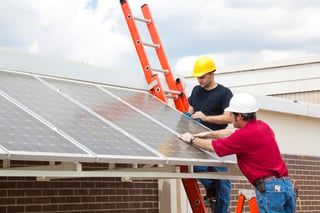 While implementing energy-efficient changes in your building has direct cost benefits due to decreased energy bills, there are also valuable tax incentives associated with energy efficiency. Incentive programs such as the 45L tax credit offer builders and developers the opportunity to maximize tax savings.
While implementing energy-efficient changes in your building has direct cost benefits due to decreased energy bills, there are also valuable tax incentives associated with energy efficiency. Incentive programs such as the 45L tax credit offer builders and developers the opportunity to maximize tax savings.
Through the Section 45L credit program, contractors earn a $2,000 tax credit for each energy-efficient dwelling unit sold or leased between January 1, 2012 and the end of 2014.
Due to the passage of the Tax Increase Prevention Act of 2014, builders and developers are able to claim this credit, also known as the federal Energy Efficient New Homes Tax Credit, retroactively for up to three years.
As an example, a recent 63-unit, multi-family project earned a federal tax credit of $126,000.
Properties Eligible For The 45L Tax Credit
The Section 45L tax credit applies to single family and multi-family dwelling units that are energy efficient and stand as tall as three stories or less. If these dwellings exceeded the 2006 Edition of the International Energy Conservation Code (IECC) heating and cooling budgets by 50%, the responsible contractor is eligible for a $2,000 tax credit.
Successful features in energy-efficient homes that qualify for the 45L tax credit include High R-Value:
- Insulation
- Roofing
- Windows
- Doors
- HVAC systems
Contractors who have worked in California are at a significant advantage for claiming this credit due to the fact that California does not use the national model for its own energy codes. The California Energy Commission (CEC) has adopted a California-specific energy code that’s been in use for over three decades.
The CEC’s energy code is significantly more stringent than the national code guiding eligibility for the 45L tax credit. As such, this tax credit is much more accessible to builders in California.
Who Does The 45L Tax Incentive Consider An Eligible Contractor?
For the purposes of 45L, a person must own and have a basis in the energy-efficient home during its construction to qualify as the eligible contractor. For example, a person who hires a third party to build a home he owns is recognized as the eligible contractor, not the third party who builds the home.
An eligible contractor must also hold a certification before earning the 45L tax credit that proves he is qualified to claim the credit. The certifier must not be related to the contractor and must be accredited by the Residential Energy Services Network (RESNET).
Part of the certification process involves the certifier conducting computer models and on-site tests to prepare a certification package. If the certifier believes under penalty of perjury that the facts in his or her report are true, and the building exceeds IECC standards, the contractor may submit for the 45L tax credit.
Due to the complexity of submitting for this valuable credit, many contractors find it helpful to consult an experienced tax professional. A tax advisor is knowledgeable about the start-to-finish process in claiming the 45L tax credit.
Tax incentives for energy efficiency are just one example of an opportunity for maximizing tax credits. Speak to a qualified CPA about other tax incentive programs to earn more credits that benefit your budget.
Learn more about taking advantage of valuable tax credits through location-specific tax incentive programs.



